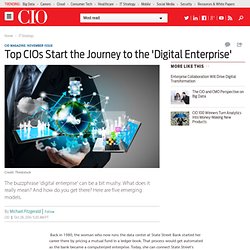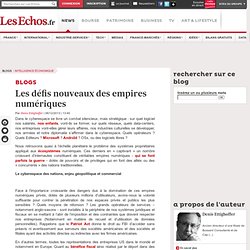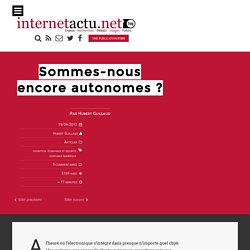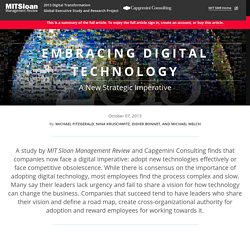

Wearing Your Intelligence: How to Apply Artificial Intelligence in Wearables and IoT. Eogez/Flickr Wearables and the Internet of Things (IoT) may give the impression that it’s all about the sensors, hardware, communication middleware, network and data but the real value (and company valuation) is in insights.

In this article, we explore artificial intelligence (AI) and machine learning that are becoming indispensable tools for insights, views on AI, and a practical playbook on how to make AI part of your organization’s core, defensible strategy. First Definitions Before we proceed, let’s first define the terms. Otherwise, we risk commingling marketing terms like “Big Data” and not addressing the actual fields. Artificial Intelligence: The field of artificial intelligence is the study and design of intelligent agents able to perform tasks that require human intelligence, such as visual perception, speech recognition, and decision-making. Machine Learning: The subfield of machine learning grew out of the effort of building artificial intelligence. Fear of AI 1. 2. 3. 4. 5. Top CIOs Start the Journey to the 'Digital Enterprise'
Back in 1980, the woman who now runs the data center at State Street Bank started her career there by pricing a mutual fund in a ledger book.

That process would get automated as the bank became a computerized enterprise. Today, she can connect State Street's systems with those of customers and partners and produce sophisticated reports to let customers analyze the mutual funds they might buy. That's the digital enterprise. "In the old days, like last week, you built systems in functional towers, based on what process you need to automate and what function you need to do for the business," says State Street CIO Chris Perretta, reflecting on his colleague's experience.
But that's not the case in the digital enterprise. "It's more a philosophy of how work is going to get done," Perretta says. Achieving this new vision is a huge thing for State Street. The digital enterprise is more than just a CIO catchphrase. [See Sidebar: Digital Transformation Starts With the CEO ] 1. 2. 3. Les défis nouveaux des empires numériques. Dans le cyberespace se livre un combat silencieux, mais stratégique : sur quel logiciel nos salariés, nos enfants, vont-ils se former, sur quels réseaux, quels data-centers, nos entreprises vont-elles gérer leurs affaires, nos industries culturelles se développer, nos armées et notre diplomatie s’affirmer dans le cyberespace.

Quels opérateurs ? Quels Editeurs ? Microsoft ? Androïd ? OSx, ou des logiciels libres ? Sommes-nous encore autonomes. A l’heure où l’électronique s’intègre dans presque n’importe quel objet (des voitures aux appareils électroménagers, aux vêtements que nous portons…) et se connectent sans fil sur le web, nous entrons dans l’ère de l’internet des objets, explique l’éditorialiste Christine Rosen pour The New Republic.

Un monde où nos interactions quotidiennes avec les objets du quotidien laissent une trace de données, de la même manière que le font déjà nos activités en ligne. « Avec l’internet des objets, nous sommes toujours (et souvent sans le savoir) connectés à l’internet, ce qui apporte des avantages évidents en terme d’efficacité et de personnalisation. Mais cela accorde également aux technologies de nouveaux pouvoirs, pour nous persuader ou nous obliger à nous comporter de certaines façons. » A qui devons-nous attribuer la responsabilité de nos actions ? Les technologies peuvent ne pas avoir d’esprit ou de conscience, affirme Verbeek, mais elles sont loin d’être neutres. Hubert Guillaud. Enjeux des technologies mobiles. Jeudi 19 juillet 2012 - Catégorie(s) : Usages. Dans son rapport « Maximizing Mobile »(Tirer le meilleur du mobile), la Banque mondiale présente des indicateurs sur la diffusion des technologies mobiles dans 150 pays et analyse les contributions de ces technologies au développement économique et humain.
Parmi les chiffres clés de ce rapport : Voir aussi : Un laboratoire pour les technologies mobiles au Kenya Ushahidi classée parmi les 10 ONG les plus performantes Internationalisation du service de paiement sur mobile kenyan M-PESA. Embracing Digital Technology. About the Authors: Michael Fitzgerald is the Digital Transformation contributing editor at MIT Sloan Management Review, covering the challenges that traditional companies face as they adopt emerging technologies.

He can be reached at michael@mffitzgerald.com. Nina Kruschwitz is managing editor and special projects manager of MIT Sloan Management Review which brings ideas from the world of thinkers to the executives and managers who use them. She can be reached at smrfeedback@mit.edu. MIT Sloan Management Review leads the discourse among academic researchers, business executives and other influential thought leaders about advances in management practice that are transforming how people lead and innovate. Didier Bonnet is a Senior Vice President and Global Practice Leader at Capgemini Consulting.
Michael Welch is a Managing Consultant at Capgemini Consulting and Visiting Scientist at MIT’s Center for Digital Business. Acknowledgments Photo Credits.